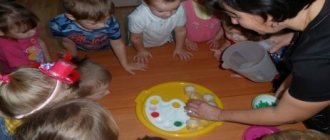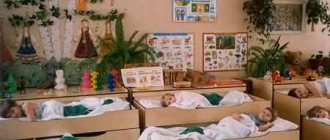Labor activity of preschoolers
Andreeva Yulia
Labor activity of preschoolers
Labor activity
1. The concept and significance of labor education for preschool children .
Labor education of preschoolers is a purposeful process of developing in children a positive attitude towards work , the desire and ability to work , morally valuable qualities, and respect for the work of adults .
Timely involvement of preschool in feasible systematic work is necessary for their comprehensive development. Labor strengthens the child’s physical strength and health, and his movements become more confident and accurate. Work requires a preschooler to be quick-witted , observant, attentive, focused, and trains his memory. Work develops thinking - the child has to compare and contrast objects and phenomena with which he deals. Labor is especially important for the moral education of a child. In work , independence is fostered, initiative and responsibility are developed. The educational nature of work was noted by progressive teachers of all times; they considered it a natural condition for the existence of the individual, a means of demonstrating his activity, vital activity and the first vital need of a healthy organism. This has been confirmed in classical pedagogical literature (Ya. A. Komensky, J. Locke, I. G. Pestolozzi, K. D. Ushinsky, A. S. Makarenko, V. A. Sukhomlinsky, etc.) and modern research ( R. S. Bure, G. N. Godina, V. I. Loginova, V. G. Nechaeva, D. V. Sergeeva, A. D. Shatova, etc.).
2. The purpose and objectives of labor education of preschool children .
The goal of the entire system of labor education is the moral, psychological and practical preparation of children for conscientious work for the common benefit and the formation of the principles of hard work . In kindergarten, this goal is achieved in accordance with the age capabilities of the children, as well as the characteristics of their work activities .
Tasks of labor education of preschool children :
1. Fostering a positive attitude towards the work of adults , the desire to provide them with all possible assistance.
2. Formation of labor skills and their further improvement, gradual expansion of the content of work activity .
3. Raising positive personal qualities in children: habits of work effort , responsibility, caring, thrift, readiness to take part in work .
4. Formation of skills for organizing your own and general work.
5. Nurturing positive relationships between children in the process of work - the ability to work cooperatively and amicably in a team, to help each other, to kindly evaluate the work of peers, to make comments and give advice in the correct form.
3. The uniqueness of the work activities of preschool children .
The work of adults creates material and cultural values, is socially useful, and is recognized by people as a necessity and a need. The value of child labor in its educational value.
The uniqueness of the work activity of preschoolers is that :
1. work is closely related to play. While performing a work task , kids often switch to play. Older children also often use games while working. Sometimes while playing, children have a need for some object. Then, to make the game more interesting, the guys make it themselves. In games, preschoolers love to reflect on the work of adults and their relationships.
2. Work activity is constantly evolving. The formation of each of its components (skills, goal setting, motivation, work planning, achieving results and its evaluation) has its own characteristics.
Formation of labor skills : at an early age, a child develops only the prerequisites for mastering tool operations. Mastery of the simplest tools occurs in preschool age .
Goal setting: children of primary preschool age do not yet know how to set goals in work . This ability in children develops gradually in the process of self-care. First, the teacher sets the goal. Older preschoolers set goals themselves when performing everyday duties, but they do this only in familiar situations. When conditions change, they should be told what to do. The ability of children to independently set goals develops most successfully in those types of work where the result is a material result.
Motives for work : younger preschoolers have a more pronounced interest in the external side of work (attractive actions, tools and materials, results)
. Among older people, motives of a social nature, which manifest themselves as the desire to do something useful to loved ones, become increasingly important.
Planning: children’s planning of work activity has a number of features - they plan only the process of performing the work, not including organization (what to prepare for work, what materials to take, where to put it, etc.); outline only the main stages of work, but not methods of execution; they do not plan to monitor and evaluate their work; verbal planning lags behind practical planning.
Attitude to the result: younger preschoolers cannot yet independently see and evaluate the result of their work . This is done by the teacher at the end of the work process . In older preschool age, attitudes towards work change . Before starting work, children are interested in why it is needed and who the result is intended for. The evaluative attitude towards the result of work : evaluation criteria are formed, its categorical nature is overcome, although it is easier for a child to evaluate the work of a peer than his own.
4. Requirements for the organization of child labor .
There are several basic requirements for organizing child labor :
1. Systematic nature of child labor . Each type of work contributes to the comprehensive development of the individual, but at the same time allows you to solve your own specific problems. It is necessary to structure the pedagogical process in such a way as to ensure an even distribution of all types of work and the systematic participation of each child in them.
2. Gradual workload. The amount of workload affects the child’s attitude towards work . The unbearability of labor can only cause disgust towards it. But too little load does not give a feeling of “muscular joy” (E. A. Arkin, which also makes it difficult to cultivate a positive attitude towards work . To determine optimal loads, external signs of the child’s fatigue during work are recorded: changes in complexion, skin moisture are noted, pulse and respiratory rate before and after physical activity for 3 minutes.The response from the cardiovascular and respiratory systems indicates favorable permissible and unfavorable physical activity.
3. Selection of equipment for work . equipment should be comfortable and suitable for children. Well-selected equipment that has an attractive appearance, allows the child to complete the task carefully, get results, encourages him to be active , and makes him want to work . The equipment is placed so that it is convenient for children to take it, use it, put it in order and put it in place.
4. Creating a working atmosphere . The daily life of a child in kindergarten is filled with work activity . This requires work effort , and from the teacher - constant attention to how carefully and timely his pupils carry out work tasks, what attitude they show towards things, order, and peers. The teacher should constantly remember his role as a group leader. When taking on any task, he certainly organizes the children to complete it. In this way he creates in the group an atmosphere of constant employment, constant striving for useful work.
5. Types of work activities of preschoolers .
According to its content, the work of preschool children is divided into four types: self-service; household work ; labor in nature ; manual and artistic work .
Self-care is the work of a child aimed at serving himself: dressing and undressing, eating, sanitary and hygienic procedures. The quality and awareness of actions is different for different children, so the task of developing self-service skills is relevant at all age stages of preschool age . The content of work changes at different age stages and as children master work skills .
Household work requires the ability to maintain order in a group room, at home, on a site, and participation in organizing everyday processes. A characteristic feature of this type of work is its social orientation. It is necessary to form in preschoolers an idea of the importance of household labor for everyone and for everyone personally. This type of work involves the formation of household labor acquired by children in a preschool institution and in the family.
Labor in nature is distinguished as a special type . The content of such work is caring for plants and animals, growing vegetables in the garden, landscaping the site, participating in cleaning the aquarium, etc. Labor in nature has a beneficial effect not only on the development of work skills , but also on the education of moral feelings, laying the foundations of the ecological culture of preschoolers . This type of labor has its own characteristics: the result can be a material product (vegetables grown by the child, a tree planted by him, etc., this brings child labor closer to the productive labor of adults ; labor in nature most often has a delayed result; it makes it possible to simultaneously develop the cognitive interests of preschoolers (children observe the growth and development of living objects, learn about the characteristics of some plants and animals, experiment, learning about inanimate nature); this type of work gives children the opportunity to bring joy to other people. Thus, work in nature contributes not only to labor education , but also moral, aesthetic, mental, physical development.
Manual and artistic labor in its intended purpose is work aimed at satisfying the aesthetic needs of the child. Its content includes the production of crafts from natural materials, paper, cardboard, fabric, wood. This work contributes to the development of imagination and creative abilities; develops small arm muscles, promotes endurance, perseverance, and the ability to finish a job.
6. Forms of organizing the work of children in preschool institutions .
The content of work is realized in different forms of organization. the work of preschool children have been developed in science and put into practice : assignments, duty, general, joint, collective work .
Labor assignments are the simplest form of organizing children's work . This is a request from an adult addressed to a child to perform some labor action . Assignments play a big role in younger groups, because children do not know how to work on their own initiative. They are introduced from the first days of children’s stay in kindergarten and are of great importance for the development and education of children (interest in work , responsibility for assigned work, etc. is formed) in all age groups. But assignments are especially important in the period from 3 to 5 years:
Instructions always come from an adult.
The instructions define a specific task and a clear focus on obtaining a result (what and how to do it)
.
Assignments create opportunities for individual work with children.
In the process of carrying out assignments, it is convenient to monitor the availability of work skills , the child’s attitude towards the assigned task, and the ability to complete the work.
According to the form of organization, work assignments can be individual, subgroup, general; by duration - short-term or long-term, permanent or one-time: by content - correspond to the types of labor .
So, assignments allow you to solve various educational problems and are widely used in preschool institutions, taking into account the age and individual characteristics of children.
children’s work compared to assignments ; these are the first responsibilities of preschoolers . Duty duties require children to have sufficiently developed independence and require the child to perform work aimed at serving the team.
Duty involves the work of one or more children in the interests of the entire group. On duty, to a greater extent than on assignment, the social orientation of work , the real practical care of several children for others, stand out. This allows children to develop responsibility and care for people.
In preschool practice, it has already become traditional to be on duty in the dining room, in a corner of nature, in preparation for classes (if a lot of preparatory work is required to provide all children with materials and tools). In the second half of the year (at the end)
in the second junior group or at the beginning of the middle group, canteen duty is introduced, since it is most accessible and understandable to children.
Duty to prepare for classes requires children to concentrate. It is introduced in the middle group from the second half of the year. Since the content of this duty is not as constant as the duty in the dining room, children should be helped and reminded of what should be on the tables when drawing with pencils, paints, modeling, designing. When the work is completed, the teacher asks those on duty to check if everything is in place.
Duty in a corner of nature is organized from the senior group, since it requires a large amount of knowledge about nature. Children on duty during the day must be responsible for living objects in the group. The teacher needs to help the children, distribute responsibilities for the whole day: the fish can be fed in the morning, and the plants can be watered later.
In a preschool institution, duty duties have their own characteristics:
contribute to the systematic inclusion of children in labor ;
require more independence from the child;
knowledge of the sequence and scope of work is required;
have social significance for the entire team;
assignments are given in a generalized form.
The selection of duty officers has its own characteristics:
uniting children with the same attitude towards work ;
association on the principle of “whoever wants with whom”
;
association based on mobility (mobile with sedentary)
;
association by alphabet (in the preparatory group)
.
Immediately before duty, you should remind the duties of those on duty or ask the children these duties (so that they remember them)
.
Requirements for duty:
1. The work of attendants should not replace the work of adults , since it is organized in a preschool institution for educational purposes.
2. During the day, the child can participate in one type of duty.
3. During the year, all children must be on duty one by one.
4. The appointment of duty officers is carried out daily; in established groups, appointments for 2-3 days are possible.
5. While on duty, observe sanitary and hygienic conditions.
6. The duties of those on duty become more complex gradually.
7. In the middle group, the organization of duty in the dining room takes the form of side-by-side work : at each table there is a separate attendant; in older groups there are people on duty (2-3 children)
serve all tables and distribute responsibilities among themselves independently.
Thus, despite the seemingly insignificant result of labor , duty is of great importance in raising children. Duties help in accessible specific matters to form in children a desire to work for the sake of others , to show a caring attitude towards their comrades, to animals and plants located in a corner of nature, to notice where adults need help.
If assignments and duties have become systematic, permanent forms of organizing work in a group and the children have achieved certain success, it becomes possible to move on to a more complex form - collective work . This form of organizing work contributes to solving the problems of moral education, the formation of the principles of collectivism, the ability to coordinate their actions, help each other, establish a uniform pace of work, etc.
When determining the content of general work, the teacher includes in it only those types of work , the skills of which the children master well enough, and strives to keep all children occupied. For example, while cleaning the room, you can find something for all the children to do. When organizing the collective work of children of the entire group , it is advisable to divide them into several units, each unit is offered a common task. For example, one link washes clothes, another puts toys in order, etc. The number of links should not exceed four. The composition of children in each unit may be constant, but the tasks they perform will change. This ensures the gradual inclusion of each child in work.
So, collective work of children is work that unites several or all children at once and has a common result. Teamwork is characterized by children coming together to achieve a common goal.
Based on the research of V. G. Nechaeva and R. S. Bure, we can conclude that in kindergarten two types of collective labor : common labor and joint labor . In the process of common labor , each child performs his own task, independent of other participants in the labor , but the result of the labor is common .
In the preparatory group, in addition to common work, they use a more complex form of organizing children - joint work , which is characterized by the fact that the work of another child depends on the work of another . Joint work gives the teacher the opportunity to cultivate positive forms of communication between children: the ability to politely address each other with requests, agree on joint actions, and help each other.
It should be noted that there is another point of view labor
general labor is work that is performed by several (or all)
children for a common goal.
Form of organization - associations into subgroups and individual work ;
joint work - work in subgroups . Each subgroup has its own business, the result of the work of one child depends on the other. It is not necessary for all children to participate;
collective work - can be general and joint, but with the obligatory inclusion of situations involving mutual assistance, support, and shared responsibility for the result.
Conclusion.
Thus, we can conclude that the work activity of children in a preschool organization can be successfully used as a means of educating and developing a child only if the forms of its organization are correctly determined in all groups, which have their own characteristics at each age stage. .







